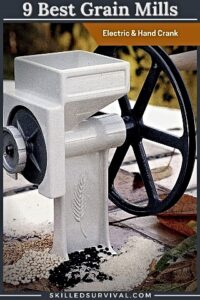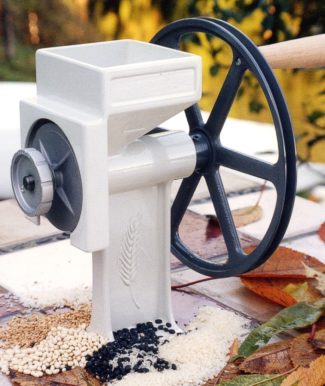
A Complete Guide To Finding And Using A Hand Grain Mill
Because anyone who stockpiles food should invest in a grain mill grinder.
It’s the BEST way to turn whole grains into meals and flour.
Plus, it gives you ultimate control of your bread and baked goods…
So today, I’m going to share everything I know about grain mills.
TOPICS IN THIS GUIDE… ↓(click to jump)
- Best Grain Mills On The Market
- What Is A Grain Mill Anyway?
- Reasons Why You Should Own One
- 3 Main Types Of Grain Grinders
- Power (Electric Vs. Hand Crank)
- Best Grain Mill Grinder Features
Best Grain Mills On The Market Today
There are hundreds of grain mills on the market today.
And ALL of them make lofty claims about efficiency, self-preparedness, and frugality.
But in the end, the best grain mill is the one that meets your needs.
That’s why we cover lots of options:
- From an inexpensive hand-cranked mill that will turn out coarse meal
- To complex electric mills capable of feeding a large family bread and pancakes all week long
Most grain mills on our list look like they'd be at home in a commercial kitchen (or a workshop). Yet, the KoMo Mills Classic is designed to be both efficient and beautiful.
The beechwood housing is held together with tight finger joints. This craftmanship makes for a durable framework for the internal corundum-ceramic "stone" burr grinder.
It's easy to adjust the grind texture from extra fine to barely cracked. And the results are consistent each time.
The large turned bowl hopper holds over 2lbs of grain, and a matching lid keeps down the noise and dust.
The drawback?
As a piece of kitchen art, the KoMo Mills Classic is expensive!
PROS
- Quiet
- Beautiful and solid construction
- Fast processing
- Wide range of grind textures
CONS
- Expensive
- Cannot process wet or oily foods (nuts, etc.)
↓ KoMo Grain Mill Review And Baking Fresh Bread
↓ How To Mill Grains With The KitchenAid Grain Mill
If you're looking for a very simple manually operated mill, the CHARD GM-150 is an inexpensive option.
The casting quality is better than some of the even less expensive models. But it's still a little rough around the edges.
While it's possible to mill from coarse to fine flour, the GM-150 seems to excel at the middle of the range. But, of course, we're talking medium-grit flour, where it mills roughly 1lb per minute with a hand-crank.
If you want more refined flours, plan on multiple passes at successively finer settings. This multistep process works far better than trying to mill to the final texture initially.
Please give it a good cleaning when it arrives, though. The factory seems to coat things liberally in protective oil to prevent corrosion.
PROS
- Inexpensive
- Fast processing (for a hand crank)
- Large capacity
CONS
- The finish could use work
- Needs thorough cleaning before use
↓ Wheat Grinder In Action – Hare White Wheat
Most impact mills rely on concentric rings of stainless-steel fins. Yet the CGoldenwall 300g has a mechanism more like a spinning blade coffee grinder.
This setup makes for a swift processing electric mill. One that's also capable of grinding wet or oily materials like nuts.
It has some good safety features which prevent the motor from starting without the lid. This feature is a crucial feature with a 28,000rpm spinning blade.
But like inexpensive coffee grinders, this mill can produce some uneven grind textures. You can go from fine to coarse in one batch.
Also, the motor is prone to overheating if used for long durations, so working in smaller batches is best.
PROS
- High-speed processing
- Can process wet/oily materials
CONS
- Inconsistent grind texture
- Overheats if used for long periods
The Wondermill electric grain mill comes highly rated, both by customers and critics.
It has an impressive milling rate due to a high-speed motor. And well-tuned impact milling mechanism can turn 2 cups of grain into fine flour in under a minute.
They even claim to be able to process over 100lbs per hour! Though that's a chore likely best left to a small commercial mill.
With a lifetime warranty, you could give it a try, though! Unfortunately, like most impact mills, the Wondermill is on the louder end of the spectrum.
One issue noted, there are only three distinct texture settings (pastry, bread, coarse). So, dialing in the exact texture you need (and anything outside that range) isn't possible.
Still, the self-contained, easy-clean system is excellent for most users—the combination of these features contributes to its overwhelming popularity.
PROS
- Fast
- Large processing capacity
- Easy cleanup | good dust filtering
CONS
- Loud
- Limited range of texture settings
The Victoria hand-cranked grain mill is a capable device. It's ready for milling anything from raw grains to nuts to spices to even cooked meats!
The adjustments to the milling texture are simple. But does take a bit of learning as there are no set points on the screw mechanism.
But this does mean that the texture is infinitely variable and can be fine-tuned to your exact needs.
One thing to note - the manufacturer states:
The milling mechanism needs 1-2 loads of dried hard beans run through it to remove any burrs left over from the machining process. And the whole assembly should be cleaned and oiled between uses to prevent corrosion.
PROS
- Inexpensive
- Quiet
- Fast, especially for coarse grinds
CONS
- More maintenance is needed than other models
- Not capable of extra refined flours for pastry use
↓ Victoria Corn Mill – Great For Making Grits & Masa
Many of us know Blendtec from their infamous "Will it Blend!?" video series.
The video series where they transform many objects into a fine powder in a Blendtec countertop blender.
Their Kitchen Mill doesn't have the same flashy ad campaign. But it does quickly and efficiently turn dried grains into flour!
It features a simple design, with an:
- integrated hopper
- micronetic milling mechanism (say that 5 times fast)
- flour container
The fast-processing rate (up to 24 cups of flour in under 6 minutes) does quick work and saves time in the kitchen.
It's on the expensive side, but Blendtec has a reputation for quality and service that's worth a bit extra.
PROS
- High feed rates
- The all-in-one design includes a clear flour bin
CONS
- Expensive
- Plastic parts
↓ Blendtec Grain / Flour Mill Demo
An efficient and versatile hand-cranked mill is the Roots & Branches Hand Wheat Grinder. AND it can process more than just wheat.
The clean design and well-fit parts, and ergonomics make it efficient to use and easy to store.
The stainless-steel cone-shaped burr mills are precision machined. And ensure a consistent grind texture, which is easily adjustable on the front dial.
↓ Unboxing My Roots & Branches Hand Crank Mill
If you're looking for a larger capacity, the Delux model has a larger capacity. And an optional electric motor attachment for a slight price difference.
But milling your own grains is a great way to control the cost and composition of the flours and meals.
PROS
- Compact design stores easily
- Efficient flywheel design
- Fast processing rates
- USA Made body from solid cast aluminum
CONS
- Large footprint
- Heavy for transport
- Expensive
↓ Country Living Grain Mill – 9-Year Review
What Is A Grain Mill?
If you’ve ever been to one of those “living history museums,” you’ve likely seen an old-fashioned stone mill.
These ancient mills are all similar but powered by different methods:
- a water wheel
- draft animals
- or even human effort
These stone mills spin two close-fitting wheels of coarse stone against each other.
This process crushes dried grains into flour.
The coarseness of the stones and the gap controls the result.
For example:
- A larger gap gives you a coarse meal
- While a small gap results in a fine powder
↓ Millstones – Wheat Flour Milling
These stone mills worked and served communities for thousands of years.
And yet, they had some significant drawbacks.
First off, building a large mill was costly.
And it involved sourcing a lot of constant power to keep the wheels spinning.
Even a smaller, homestead mill relied on stone wheels weighing a couple hundred pounds.
And the stones, which ground against each other constantly, slowly wore away.
So, they left tiny bits of stone in the flour.
Today’s modern mills are FAR easier to use.
They take advantage of advances in materials and design to make them:
- More efficient
- Safer
- And affordable
For example:
The electric-powered ones (or finely machined hand cranks options) turn sharp, metal burr grinders.
These modern mills allow for texture control at the twist of a knob.
Want a free 78 item preppers checklist?
Enter your email below to instantly download this Complete Checklist PDF. No purchase necessary. 👇 👇6 Reasons Why You Should Invest In One
1. Quality & Health Benefits
One of my first jobs was making specialized bread as a baker’s assistant.
I learned two things very quickly:
First, there’s a difference between being a “morning person” and a “baker”:
Being a baker means being at work 3 hours before the morning person wanders in for their fresh baked bread.
Second, and far more important:
When working with so few ingredients, they must be top-quality IF you want your products to stand out.
That’s why the best local bakeries invest in a quality mill grinder.
For example:
We went through hundreds of pounds of flour each day.
But we never used processed flour.
Instead, we ran 50lb bags of whole grains through an industrial flour mill.
At first, I thought it was a cost-saving technique.
A way to profit more from each baguette we sold.
But one day, I did the math.
I quickly realized the owner paid as much labor as he had saved on bulk flour!
So, why did we do this long, dusty chore every day?
Quality
Quite simply, the grains we milled made a difference in:
- Texture
- Freshness
- And nutritional content
And we milled the exact mix we needed for each type of bread.
Instead of buying large quantities of the more exotic grains.
Trust me:
You won’t find a couple of cups of amaranth or einkorn flour on the shelf at the supermarket.
And we had total control over the quality of grains that went into all our different types of flour.
So it never had fillers, preservatives, or additives.
So, if you don’t own a healthy foods bakery, why would YOU choose to grind your own grains?
Well, we know eating whole grains can lead to the following:
- better cardiovascular health
- fewer issues with diabetes
- less weight gain
- and reduce stomach and intestinal inflammation
We hear about these health benefits on the news, in food commercials, and when we talk with our doctors.
But if those aren’t good enough reasons, here are a few more:
2. Price – Savings
The price of whole grains can be drastically less than flour produced from the same grain.
You can save some serious cash if you’re not paying someone to mill hundreds of pounds of it for you.
Call it “sweat equity” if you like.
3. Ingredient Control
Milling your own flour gives you complete control over the contents of your flour.
For example:
- You can customize mixes for flavor or nutrition upgrades
- You can 100% ensure you avoid wheat gluten cross-contaminating your rice flour
The bottom line:
Milling your own grains give you ultimate control.
Knowing exactly what is going into each bag.
4. Flavor Enhancement
Fresh-ground grains have a more complex flavor profile.
Way more flavor than the mass-processed flour shipped throughout the world.
Many of these bland flavors and scents are due to organic compounds in the grain.
These organic compounds degrade over time.
This fast degradation contributes to most store-bought flour’s flat, bland taste.
And if you want to change the nutrition and flavor profile of the grains, try sprouting or malting grains.
This process involves soaking them in water and allowing them to germinate.
At this point, drying them out again stops the process.
Drying helps the seeds convert starches to sugars, which releases a different, richer flavor in the resulting flour.
↓ How To Make Sprouted Grain Flour – SO Easy!
5. Long-Term Food Storage
Whole grain kernels last far longer in storage than processed flour.
If stored properly, they can last months or years.
6. Homebrewing
For many people, the homebrew store is their first introduction to a grain mill.
To make your own beer, you use ground malted barley and other grains.
If you live far away from a homebrew store, milling your own grains at home makes sense.
It’s one of the best ways to ensure you have the best ingredients for your next batch!
3 Main Types of Grain Mill Grinders (Pros & Cons Of Each)
There are three major categories of milling mechanisms found today:
- Stone burrs
- Steel burrs
- And impact micronires
The type used directly relates to your grinder’s performance, cost, and longevity.
1. Stone Burr Mills
Stone burr mills come in a wide range of sizes and milling rates.
Unlike the old natural stone mill discs, modern “stone” burr mills use an engineered material.
As a result, they provide a high level of durability, precision, and uniform milling texture.
The tight tolerances and fine texture allow stone burr mills to produce a wide range of products.
They can make everything from “cracked” grains to ultrafine flours.
If you plan to do a lot of baking, a stone burr mill might be your best bet.
But, due to the porous nature of the grinding surfaces, they’re not great for oily, wet, or fibrous materials.
2. Steel Burr Mills
Steel burr mills are like stone burr mills in capability and longevity.
The difference is that very few can match a stone burr mill in producing the most refined flours.
On the plus side, due to their non-porous steel surfaces, they can grind oily, wet, and fibrous materials.
A steel burr mill is a far better choice if you want to make homemade peanut butter.
In addition, they’re far less expensive than a premium stone burr mill.
And they come with a wide range of options, including different power methods (more on that in a second).
3. Impact Mironizers
Finally, the newest milling mechanism is the impact “micronizer.”
It’s essentially a pair of stainless-steel discs with concentric rings of raised “fins.”
While one disc is fixed, the other spins at extremely high speeds.
This breaks the grains into smaller pieces as they pass through the gaps between rings.
They’re fast and loud and only come in electric versions.
They can produce a vast range of different flour textures.
But are not capable of either the coarsest or finest grinds that burr mills can achieve.
An impact mill is also unsuitable for oily, wet, or fibrous materials.

Want a free 78 item preppers checklist?
Enter your email below to instantly download this Complete Checklist PDF. No purchase necessary. 👇 👇How To Power A Grain Mill (Electric Vs. Hand Crank)
One of the major decision points is deciding between an electric mill and a hand crank one.
Each type has benefits, so you must evaluate how they work in your plans.
Electric Grain Mills
An electric one features a powerful motor to drive the grinder.
This setup provides a low-effort means to grind a LOT of grain into flour fast.
Most have a large hopper to feed raw whole grains.
And can be fitted with a similarly large container to collect your newly milled flour.
This scalability means your only real job is to keep the hopper full.
PROS
- Simple to use
- Fast
- Can process large volumes of grain
CONS
- It doesn’t work when the power goes out
- It can be quite loud
- Electrical parts can fail
- Expensive
Hand Crank Grain Mills
Hand-cranked grain mills take a bit more effort.
But they work even when the power goes out.
So this setup is something to consider if milling is a part of your emergency preparedness plan.
In addition to keeping the hopper full, you have the added chore of spinning a crank by hand.
Some models also feature alternative attachments if you’re not up for an arm workout.
These allow you to drive the grinder wheels via a bicycle or other power source.
PROS
- Durable
- Works off the grid
- Inexpensive
- Quieter operation
CONS
- Lots of effort
- Slow to mill larger volumes
↓ Electric Wheat Mill Vs. Hand Crank Grinder – Make Flour
Best Grain Mill Grinder Features To Look For
Milling Rate
If you’re looking at manual grain mills, the milling rate is directly tied to your own efforts.
A slower milling rate will take longer to produce the required amount for your recipe.
It will also tie you up in the milling process for longer, keeping you from working on other tasks.
If you’re considering electric mills, the milling rate is far less of a factor.
You can walk away and get other things done while the mill works through the grain.
Noise Rating
Hand-cranked burr mills are relatively low noise.
Faster electric burr mills and impact mills can create a lot of extra sound due to their high speeds.
Consider this when selecting your work area if you’re processing a lot of grains.
A covered outdoor space or garage is often best for loud mills.
Capacity
Most mills have a capacity rating based on how much grain you can load into the hopper.
For most manual mills, the capacity is small.
But you’ll appreciate the break from constant cranking to refill the hopper occasionally.
A larger hopper is an excellent addition for electric mills, allowing you to go hands-free for longer.
The batch sizes get much more extensive in larger consumer and light commercial mills.
And the hopper can hold far more raw whole grain.
Materials & Build Quality
As with any product, higher-quality materials are a plus.
These are hard-working pieces of equipment and need to be durable.
Flimsy plastic or thin metal construction is likely to fail.
And likely when you least expect it.
Investing in solid cast metal or a high-quality hardwood body is best.
And engineered stone or stainless-steel grinding mechanisms are preferable.
Final Thoughts
The taste, nutrition, and sense of satisfaction that comes with milling your own grain fresh can’t be beat.
This does double if a run to the store for a cup of flour isn’t possible.
Plus, YOU can choose to experiment with wild or exotic grains.
Or purchase more common whole grains in bulk with extended storage shelf lives.
Whatever your reasons, it’s a wise investment from all sides.

Prepare, Adapt & Overcome,
P.s. - I just found out 2 out of 3 Americans don’t feel prepared for a 3 day disaster!!!
I guess this goes to show how modern society continues to embrace ‘living a fragile life.’ What’s crazy is… it’s so easy to fix.
To make sure YOU have the basics, watch our FREE training on “10 Simple Steps To Basic Preparedness” that shows you HOW.
Nothing crazy here… this isn’t doomsday prepping... just the basics every responsible adult should have before a disaster strikes.Why You Can Trust Skilled Survival...
Go here now to review a full breakdown of:
- Who We Are
- Our Credentials
- Our Mission
- & Product Recommendations...
Here are a few highlights of our teams credentials & certifications:
- Certified Member of a Mountain Search & Rescue Organization
- Plant Emergency & Safety Leader for a Major Food Manufacturer
- Member of the 10TH Mountain Division Hut Association
- Certifications: Avalanche 1, WFR, CPR
- Official Gear Tester for Numerous Outdoor Gear Companies
- Countless Multiday Backpacking trips into Remote Wilderness
- Bachelor's Degree In Mechanical Engineering
- Bachelor's Degree In Civil Engineering
- Bachelor's Degree In Biomedical Engineering
"It takes 20 years to build a reputation and five minutes to ruin it." - Warren Buffett
We're fully aware that trust is NOT something you GET but is EARNED.
And we'll continue to earn YOUR trust through our forthright and honest approach with each new Blog Post, Guide & Product we create...
P.s - I just took this FREE 60-second 'Readiness Score Quiz'👇
AND... I've still got a few gaps in my preps...🤔 But at least, I'm not part of 'The Fragile Masses'. 👍 Find out where YOU stand by answering a few questions...

Recommended Reading
Canned Meat: The Best Ones To Round Out Your Stockpile
Not all canned meat is created equal. Most are great for a quick meal but few are good enough for your emergency stockpile.
Best Powdered Milk With An Insanely Long Shelf Life
Not all powdered milk is created equal. We've uncovered all the best deals and share tactics on how to significantly extend it's shelf life.
Best Powdered Eggs (& Deals) On The Market Right Now
The best powdered eggs are tasty, affordable, long lasting and worth buying! In this guide, we review the best ones to make your search easy.
Best Canned Bread (& Mixes) With Insanely Long Shelf Lives
The best canned breads are tasty, affordable, long lasting and worth buying! In this guide, we review the best ones on the market to make your search easy.
Peanut Butter Powder: Best Ones With Insanely Long Shelf Life
Best Peanut Butter Powder for long term protein storage - 1. Ready Hour 2. Augason Farms 3. Legacy Foods 4. PBfit 5. Naked PB 6. PB2 Pure...
Best Honey Powders With An Insanely Long Shelf Life
Looking for the best honey powder for emergencies? We break down the best deals and how long powdered honey can last on your shelf.














